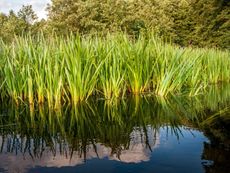Sweet Flag Care: Tips For Growing Sweet Flag Grass


Japanese sweet flag (Acorus gramineus) is a striking little aquatic plant that tops out at about 12 inches (31 cm.). The plant may not be statuesque, but the golden-yellow grass provides plenty of bright color in soggy garden spots, along streams, or pond edges, in semi-shady woodland gardens-- or nearly any area where the plant's moisture requirements are met. It is a good choice for stabilizing the soil in damp, erosion-prone soil. Read on for more information about Japanese sweet flag.
Arorus Sweet Flag Info
Japanese sweet flag, also known as Calamus, is native to Japan and China. It is a cooperative, slow-spreading plant that attains a width of 2 feet (61 cm.) in about five years. Miniature greenish yellow blooms appear on spikes in spring and early summer, followed by tiny red berries. The grassy leaves emit a sweet, rather spicy aroma when crushed or stepped on. Sweet flag is hardy to USDA plant hardiness zones 6 through 9, although some Acorus sweet flag info indicates the plant is tough enough for zones 5 through 11.
Sweet Flag Care
It doesn't take much effort when growing sweet flag grass. Sweet flag plants tolerate light shade or full sun, although the plant benefits from afternoon shade in hot climates. However, full sun is best if the soil is extremely boggy. Average soil is fine, but be sure the soil is consistently moist, as sweet flag doesn't tolerate bone dry soil and may scorch. Similarly, the leaf tips may turn brown in periods of extreme cold. To grow sweet flag in a pond or other standing water, place the plant in a container and set it in water less than 4 inches (10 cm.) deep. Sweet flag plant benefits from division in spring every three or four years. Plant the small divisions in pots and let them mature before transplanting them into their permanent locations. Otherwise, growing sweet flag grass is nearly effortless.
Gardening tips, videos, info and more delivered right to your inbox!
Sign up for the Gardening Know How newsletter today and receive a free download of our most popular eBook "How to Grow Delicious Tomatoes."

A Credentialed Garden Writer, Mary H. Dyer was with Gardening Know How in the very beginning, publishing articles as early as 2007.
-
 Urban Beekeeping Guide: Top Tips For Raising Bees In The City
Urban Beekeeping Guide: Top Tips For Raising Bees In The CityUrban beekeeping can be a rewarding and appreciated pastime, but first be sure it’s legal in your city and learn the ropes of beekeeping.
By Mary Ellen Ellis
-
 2024 Plant Of The Year: Why Experts Say Philodendron Is The “It” Plant Of The Year
2024 Plant Of The Year: Why Experts Say Philodendron Is The “It” Plant Of The YearWe aren’t surprised that philodendron was designated the plant of the year. Versatile, easy-care and lovely, it’s the houseplant of the year 2024!
By Bonnie L. Grant
